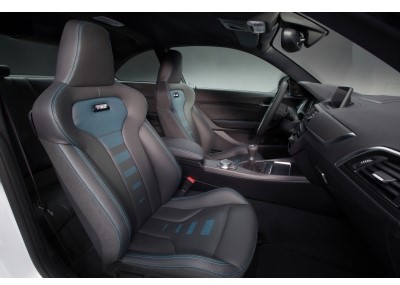MUNICH, Germany – BMW’s M division ramps up the performance potential of its 2-year-old M2 with the introduction of an upgraded version of the compact rear-wheel-drive coupe.
The ʼ18 model, which goes under the name M2 Competition, replaces the standard M2, boasting a 404-hp version of the twin-turbocharged 3.0L inline 6-cyl. S55 gasoline engine powering the M3 and M4.
The new engine endows BMW’s latest M model with a claimed 0-62 mph (100 km/h) time of 4.2 seconds in combination with an optional 7-speed dual-clutch gearbox as well as a limited 155-mph (250-km/h) top speed.
Conceived to further enhance the standing of the BMW coupe against rivals such as the Porsche Cayman GTS and Audi TT RS, the new M2 Competition not only receives an injection of performance but also adopts a number of subtle chassis changes that BMW M division’s head of development, Dirk Häcker, says provide it with “significantly improved response and more progressive on the limit characteristics” than its direct predecessor.
“We have altered the steering mapping, changed the spring and damper tuning and recalibrated the DSC (dynamic stability control) system as well,” Häcker says. “It is still the benchmark in its class in terms of response and reactions, but it now slides with greater progressiveness and enthusiasm.”
The M2 Competition adopts a number of visual upgrades over the model it replaces, giving it a more aggressive appearance along with added cooling efficiency required by its new engine.
Up front, there is a more heavily structured bumper with larger cooling ducts, a redesigned kidney grille with wider individual elements and advanced headlamps with an adaptive LED function as standard.
Further visual changes include new M-style exterior mirror housings similar to those employed on the M3 and M4 as well as lightly reworked taillamps, an altered rear bumper and, standard in North America, newly designed 19-in. forged alloy wheels shod with Michelin Pilot Sport tires.
Inside the M2 Competition, several subtle changes differentiate it from the M2 launched in 2016. Included are new M Sport front seats, reconfigured M instruments, so-called M seatbelts in various colors, the M Drive manager function from the M3 and M4, park distance control for both the front and rear and an engine start button in red.
Power for the latest M model hails from a detuned version of BMW M division’s existing S55 gasoline engine used by the soon-to-be-discontinued fifth-generation M3 and first-generation M4. In the M2 Competition, the S55 delivers 404 hp on a band of revs between 5,250 and 7,000 rpm and 405-lb.-ft. (549 Nm) of torque between 2,350 and 5,200rpm.
This represents a 40-hp and 62-lb.-ft. (84-Nm) increase from the original M2’s less heavily tuned turbocharged 3.0L inline 6-cyl. N55 gasoline engine, but 21 hp less and the same torque loading as the more heavily tuned version of the S55 engine used by the M3 and M4.
The M2 Competition’s curb weight is up 121 lbs. (55 kg) on the earlier M2 at 3,417 lbs. (1,550 kg) in 6-speed manual guise, due in part to the added weight of its new engine. Yet despite this, its weight-to-power ratio improves to 8.4 lbs. (3.81 kg) per hp.

Drive is channeled through the same standard 6-speed manual and optional 7-speed dual-clutch gearboxes as the earlier M2. They operate in combination with BMW M division’s electronically operated multiplate limited-slip Active M Differential, which gives the rear wheels a locking effect of between 0-100% depending on factors such as prevailing traction, yaw rate and steering angle.
BMW’s official performance claims for the M2 Competition point to a 0-62 mph (100 km/h) time of 4.4 seconds for the standard manual version and 4.2 seconds with the optional DCT. Both achieve a nominal top speed limited to 155 mph (250 km/h), although it can be raised to 174 mph (280 km/h) with an optional driver’s package.
Further changes brought to the new M Competition include an optional brake package. It replaces the standard 15.0-in. (381-mm) front and 14.6-in. (371-mm) rear discs with four-piston front and two-piston rear calipers, with larger 15.7-in. (399-mm) front and 15.0-in. rear discs fitted to six-piston front and four-piston rear calipers.
The M differential has been upgraded with new software that Häcker says has allowed vital changes in the DSC system via a new M Dynamic Mode activated in the Sport Plus driving mode. “It now intervenes later, allowing a greater oversteer and more controlled drifts. However, the DSC can still be relied upon in critical situations,” he says.





